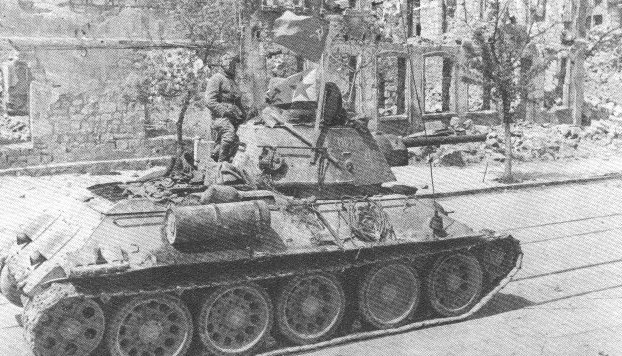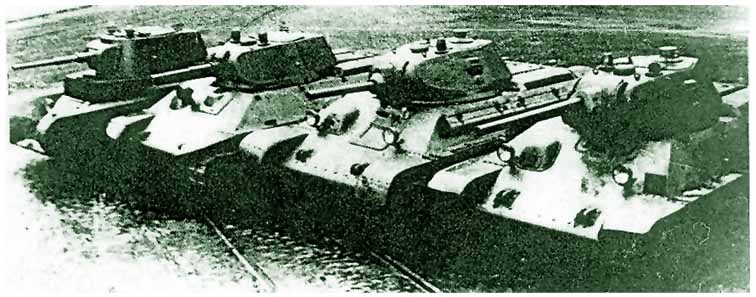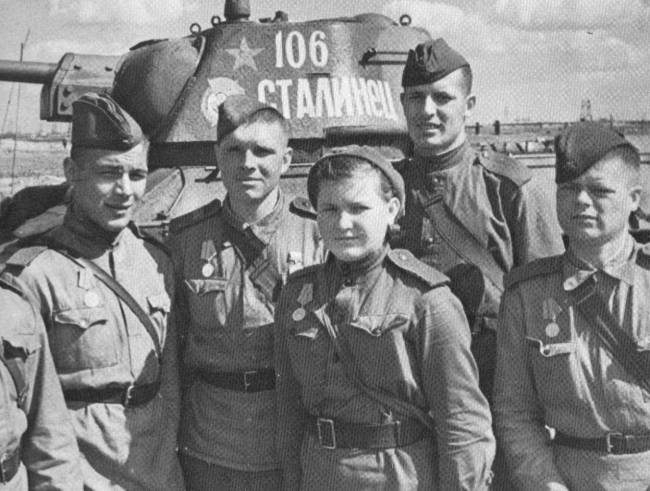Presumably the Soviet Unions T-34 had the greatest design for a tank ever developed. It balanced the qualities of armor protection, mobility and firepower. The T-34 was very reliable, simple to build, and produced in large quantities of 34.000 vehicles. The T-34 was based on the concept of Christies "fast tank" of the 1930s. T-34s designwork started in 1934, to replace the old T-28. Meanwhile the production of the BT-tank had begun, the chief engineer of the Kirov Works in Leningrad - Mikhail Koszkin -, tried to fit a T-28 with a Christie-type suspension. The test resulted in the T-29-5. This was only faster than the T-28, but it did not offer better fireaccuracy, and the type was abandoned. A design team at Komintern Factory in Kharkov, led by an engineer called Tsiganov, gave the birth of the T-34. They thought that it was better to produce a heavier version of the BT, that trying to put is characteristics on other design like the T-28. The latest BT-tank at the time was the BT-7M. One of those was given a sloped armor hull instead of the original slab-sided structure. This resulted in a BT-IS (Ispitatelinig), which showed very promising, and in 1936 a special design team led by Koszkin and A.Morozov (designer) was up at Kharkov. Morozov had designed the T-46-5, a fast medium tank, which was not taken up. In 1937 blueprints of the A-20 was made, which was an improved BT-IS.
This still had the wheel/track-option and BTs 45mm gun, but it had the T-34's shape and design. Koszkin was given the task to develop the T-30 further on. He then developed the A-32, which didn�t use the wheel/track-option, but was now fitted with a short 76mm L-11 gun (76.2mm L/30.5). The A-32 had proved very good in trials and a small production was ordered. However after battle experience in the Spanish Civil War, it was proved that the A-32 had insufficient armor protection.
The improvements led to the T-34, which didn't use the wheel/track system. On 19th of December the drawings and models of the new T-34 were submitted to the High Command who accepted them for production, even before the prototype had been completed. The production was to be taken care of by Kharkov's (KhPZ) #183 Factory. In September of 1940, the first series produced T-34s left the factory.

Interior view of a T-34/76 Model 1940 turret at the gunner's position and the breech of
the L-11 gun. Turret traverse was electrical or mechanical. Note the three ammunition
racks just below.
The T-34 was known for its excellentely shaped hull and turret and the 76mm gun of a
relative long barrel-length and its high muzzle-velocity made it to a feared devil. The
T-34's use of a diesel-engine reduced the risk for fire when hit, and gave the T-34 larger
operation range. The Christie-suspension permitted high speed in rough terrain, meanwhile
its wide tracks made it able to cross mud and snow easier and faster.The first T-34/76A
Model 1940 was delivered to the Red Army in June 1940. When Operation Barbarossa was
launched on June 22nd 1941, the production of the T-34 had not reached far enough to
employ sufficient numbers to the Red Army. (1.225 T-34/76 had been built by KhPZ and STZ
by June 22nd 1941). Approximately 2.800 T-34/76 was manufactured in 1941. At this time at
least half of the total tank strength (21.000) was deployed in a infantry-support role,
and BTs and T-26s comprised 75 percent of all tanks. Due to the speed of production
(A single T-34 could be built in just 40 hours, and production cost was lowered three
times from 1941-1943.), some of its component manufacturers were not fast enough to keep
the time-schedule. The cost per vehicle was lowered from 269.500 roubles in 1941, to
193.000 in 1942 and to 135.000 in 1943. A shortage of the new V-12 diesel engines led to
that some of the early T-34's had the older M-17 gasoline-engine (same as the BT and T-28
tanks used). A hastily laid demand for more transmissions produced some serious problems;
some early T-34s were very unreliable, and spare parts to repair the transmission were
added to the side hull.

T-34/76 Model 1942 tanks of the 45. Tank Regiment, 8th Estonian Rifle Corps, May 1943.

A late production T-34/76 Model 1943
"Mstitiel" (Avenger) entering Sevastopol.
Photo provided by Nicholas Brooks.
Apart from the incredible losses of
tanks in the 1941 campaigns (USSR lost 6.000 tanks only at the two battles at Minsk and
Smolensk), the Russians lost all their western industrial regions with its raw materials.
The training of the crews was almost not anything, when drivers and mechanics sometimes
only had 1� - 2 hours of training before they was sent to operational units.
When Germany penetrated deeper into Russia, it became necessary to move or evacuate all
factories all the way to the Urals and Siberia. After the evacuation, the T-34 was built
by Ural Tank Building Establishment (Uralmashzavod, UZTM), which was a combination of the
Komintern Factory from Kharkov and the Nizhni-Tagil Tank Plant.

Uralmashzavod vehicles - BT-7 Model 1937, A-20, T-34/76 Model 1940 and T-34/76 Model 1941.
Uralmashzavod did now produce the T-34
under the command of J.E.Maksarov, with A.Morozov as the Chiefengineer. In July 1942 the
factory received the first blueprints of the T-34, and the first production model from
Uralmashzavod was called "Comrade Stalin". The T-34 came as a sad surprise to
the Germans when they encountered them in quantity in July 1941. (Even if the T-34 engaged
the Germans for the first time on June 22nd at Grodno). When the Germans engaged them they
noticed that all their tanks had suddenly become obsolete and undergunned, for they were
not a match to the T-34 either in speed, hitting power or protection. For example, Dimitry
Lavrynenko and his crew destroyed 52 German vehicles in the first months of the war.
Lavrinenko was later killed in action in the Battle for Moscow in late 1941. This new and
dangerous tank, superior to any German vehicle, immediately led to the Germans speeding up
the development of the heavy PzKpfw. VI Tiger tank and the designwork of a medium tank
with a similar design as the T-34, later to be known as the PzKpfw. V Panther, which owed
its appearance and features directly to the T-34.
There were many soviet tank crews, heroes of the Soviet Union who fought with T-34/76s,
and it was also used by Polish, Czechoslovak and Yugoslav tank units. The Germans were
happy to issue as many captured T-34's to their units as possible, as well as Finnish,
Hungarian and Rumanian armed forces.

T-34/76 Model 1943. Texture on turret - "Staliniets". 30th Guards Tank
Brigade, fall 1943.

The same vehicle as above with a crew of the 30th Guards Tank Brigade.
PRODUCTION TABLE OF THE
T-34/76 and T-34/85
(Compared with German output)
| Type: | 1939 | 1940 | 1941 | 1942 | 1943 | 1944 | 1945 |
| GERMANY | - |
- |
- |
- |
- |
- |
- |
| PzKpfw. III | 206 | 858 | 1.703 | 2.558 | 235 | - | - |
| PzKpfw. IV | 141 | 278 | 467 | 974 | 3.013 | 3.126 | 385 |
| Panther | - | - | - | - | 1.768 | 3.749 | 459 |
| Total: | 347 | 1.136 | 2.170 | 3.532 | 5.016 | 6.875 | 844 |
| Output | 19.920 |
||||||
| USSR | - | - | - | - | - | - | - |
| T-34/76 | - |
approx. 270 | 2.800 | 12.520 | 15.812 | 3.500 | - |
| T-34/85 | - |
- | - | - | - | 11.000 | 7.650 |
| Total: | 53.552 |
| Armor penetration: | 100 meters | 500 meters | 1.000 meters | 2.000 meters |
| 76,2mm L/30.5 L-11 | 73mm | 62mm | 56mm | 44mm |
| Armor penetration: (Br-350A) |
100 meters | 500 meters | 1.000 meters | 2.000 meters |
| 76,2 mm L/41.2 F-34 | 88mm | 69mm | 61mm | 48mm |
* "T-34" (In 1941, few
T-34/76A Model 1940 was rearmed with 57mm ZiS-4 L/73 gun)
* T-34M (T-34/76B Model 1942 with torsion bar suspension)
* TT-34 (General name for T-34ARV)
* SKP-5 (The first ARV consisted of a T-34 chassis with a special 360 degree traverse
crane of five ton capacity.)
* T-34/STU (Dozer tank)
* OT-34 (Flame-thrower system ATO-42, re-designed based on the Churchill Crocodile.)
* TO-34 (Post-war T-34/85 with ATO-42 system)
* PT-34 (Mineclearing tank)
* T-34T (Post-war ARV, artillery tractor?)
* T-34/MTV (Post-war with a rigid ARK type bridge)
* T-34/MTU (Post-war with rigid type bridge launched by pivoting about a roller at the
front)
* PzKpfw. T-34 747 (r) - (Original T-34's)
Most of them issued to the German 2nd SS Panzerdivision "Das Reich".
Hauptscharf�hrer Emil Seibold of the 2nd SS Panzer Division "Das Reich", 2nd
Tank Battalion, is perhaps the most famous German tank commander riding a captured T-34
who destroyed some 70 Soviet tanks.
* Flakpanzer T-34 (r) - (German Flakpanzer armed with 4 x 20mm "Flakvierling")

